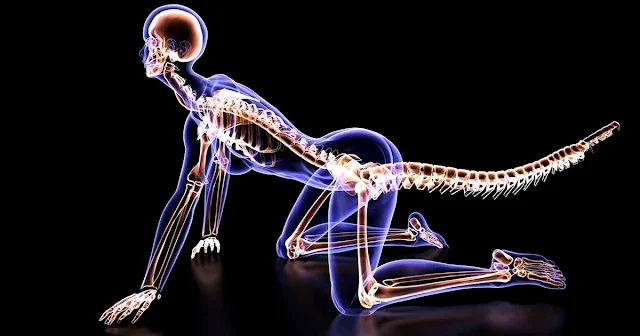One of the most remarkable changes in human evolution is the loss of our tails, a transformation that occurred around 25 million years ago. This pivotal shift not only altered the trajectory of our species but also marked a significant moment in the evolutionary history of primates. While scientists have long speculated on why humans lost their tails, the genetic cause has remained elusive—until now. A recent study published in Nature has finally uncovered the genetic factors responsible for this evolutionary change.

The Quest to Understand Tail Loss
The journey to unravel the mystery of human tail loss began in an unexpected way. Bo Xia, a graduate student at New York University, was inspired to investigate the origins of the human tailbone after injuring his own coccyx. This personal curiosity led Xia and his team to embark on a groundbreaking scientific investigation.
Through careful research, the team focused on the TBXT gene, which plays a crucial role in regulating tail length in various species. Their research revealed a unique genetic mutation within this gene, providing a major breakthrough in understanding human evolution.
The Role of Jumping Genes
A key aspect of this discovery lies in the role of Alu elements, often called “jumping genes.” These genetic elements, specific to primates, can move within the genome and cause significant changes. The researchers found that Alu elements inserted themselves into the TBXT gene, triggering a chain reaction that led to the loss of our tails.
This insertion activated a process known as alternative splicing, where RNA molecules are cut and restructured, which ultimately led to the deletion of a crucial exon. This change altered the structure and function of the resulting protein, leading to the tail loss seen in humans.
Validation Through Mice Studies
To confirm their findings, the researchers engineered laboratory mice with the same genetic mutations found in humans and apes. These genetically altered mice lost their tails, providing compelling evidence that the identified mutation plays a crucial role in the absence of tails in humans and other primates.
However, the study also uncovered a downside to tail loss: an increased risk of neural tube defects, such as spina bifida. This finding highlights the complex balance between evolutionary benefits and potential genetic trade-offs.
The Broader Implications
This discovery has profound implications not just for understanding human evolution, but also for human anatomy and health. The loss of our tails was not a random event but a genetic adaptation with lasting consequences. It illustrates the complex relationship between genetic changes and the way they shape our physiology over time.
As we continue to study our evolutionary past, these findings remind us of the intricate process of natural selection and genetic innovation that has shaped humanity. This breakthrough also underscores the power of scientific inquiry in uncovering the mysteries of our origins, offering insight into the past that can help us understand our future.
The identification of the genetic reasons behind tail loss is a testament to the persistence of scientific exploration and the ongoing quest for knowledge about our evolutionary journey.
Miss Nepal Is Facing “Cruel” Reactions for Her Participation in Miss Universe 2023
Over the 71-year history of Miss Universe, this marks the very first participation of a plus-sized contestant. The 22-year-old Miss Nepal has etched her name in history by confidently showcasing her stunning physique. While many people rallied behind her, praising her beauty, a significant portion of the global audience also levied criticism. She candidly addressed these comments, shedding light on her experiences.
She glowed with confidence.

Moises Castillo/Associated Press/East News
Jane Dipika Garrett expressed her pleasant surprise at the extent of her progress in the competition that took place in November 2023. Having harbored dreams of becoming a model, she confronted past struggles with low self-esteem. The overwhelmingly positive response she received during the competition served as a validating experience, and solidified her newfound confidence in embracing her own identity.
© international_poll / Instagram
Garrett noted that she “did not expect to get that much applause on the stage.” She went on to explain that she “wasn’t expecting anything” and was only participating to represent her country and “to represent women all over the world.”
Opinions were divided.

Despite being praised by many around the world for her gorgeous looks, the 22-year-old said that she had also faced harsh criticism from many people. She admitted that some incoming messages were less than positive, reaching the point of being described as “cruel.”
Jane revealed, “I see things like, ’Oh, she’s a whale,’ or ’Why don’t you go to the gym?’ And things like that.” She continued, “It’s like they don’t even know my story. They don’t even know what I’m going through.”
She’s not letting her struggles stop her dreams.

© Miss Universe / YouTube, MARVIN RECINOS/AFP/East News
The beauty contestant clarified that she grapples with a condition known as polycystic ovarian syndrome (PCOS). This medical condition involves the overproduction of androgens by the ovaries, surpassing the typical levels found in women. PCOS manifests with various effects, including weight gain, menstrual irregularities, acne, and excess hair growth.
© Miss Universe / YouTube, © Miss Universe / YouTube
She noted that recently she had gained a lot of weight due to her condition, stating, ’’that’s also really taken a toll on my mental health and my self-esteem because I thought that I wasn’t good enough or that I wasn’t beautiful enough.’’
Nevertheless, Garrett underwent a journey of cultivating a positive mindset and finding comfort in her own skin. Observing her radiant confidence on stage, it’s evident that she has successfully achieved this self-acceptance journey.
We concur that Miss Nepal looks absolutely stunning, and we consider it a significant stride for the Miss Universe competition to embrace and celebrate the beauty and diversity of women’s bodies in all shapes and sizes. To delve further into the realm of Miss Universe and discover how previous winners are looking today, we invite you to explore this article.



Leave a Reply